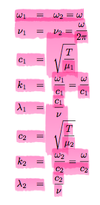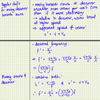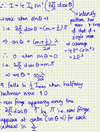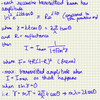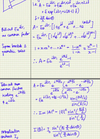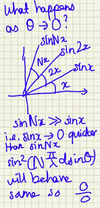1224 Flashcards
(94 cards)
How do you sum 2 oscillations with same frequency to find amplitude?
Use complex notations

What is the resultant/carrier/average frequency?
ω1 + ω2/2 or f1 + f2/2
describes net motion
What is envelope/modulation frequency?
ω1 - ω2/2 or f1 - f2/2
describes wave motion
What happens when frequency are similar for same amplitude and same phase oscillations? What is the frequency of the phenomenon?
beats i.e. oscillation at amplitude of resultant frequency is modulated by slow oscillation at envelope frequency
ω1 - ω2 or f1 - f2/2

What is the number of minima per second for beats?
Δω/π
where Δω = envelope frequency
What is the frequency for Ψ1 +Ψ2 in normal modes? And what is the frequency for Ψ1-Ψ2?

What is the general wave equation?

What are the speeds and impedances for stretched string, elastic waves and fluids in waves? And assumptions for derivation of the stretched string equations?
Small displacement of strings
T and u are independent of posn and displacement
Resolved force has small angle between x and x + Δx

What are the reflection coefficients and transmission cofficients? And what happens for z1 >> z2, z2 >> z1 and z1 = z2?
- z1 >> z2 => R=1 & T=0 => no phase change
- z1 << z2 => R=-1 & T=0 => pi phase change
- z1 = z2 => R=0 & T=1 => impedance matching like as if only one string

Define impedance as equation and in words.
Impedance is measure of resistance to oscillations (amplitude of driving force/transverse velocity)

What is the phenomenon when source is moving faster than velocity of waves in medium?
Shock waves
What is the kinetic energy density of a string? And what is the equation in terms of speed and impedance?
KE = 1/2 u (dΨ/dt)^2

What is potential energy stored in string? And what is total energy per unit length?
U (x,t) = potential energy

What is the most general solution to the wave solution?

How do you sum 2 oscillations with same frequency to find angle?

What is correponding defined qa and qb variables?

What is the rate at which energy moves along wave (i.e. power delivered along string) = rate at which is done?

What is the instantaneous KE & PE densities of any point on string under tension carrying travelling wave?

Define harmonic
integer multiple of fundamental frequency
What are the boundary conditions for string of length L fixed at both ends?

What is fundamental frequency?
Lowest resonant frequency of a vibrating object i.e. 1st harmonic
What is another general solution to general wave equation involving k? Why can you do this
Scaling x by a constant does NOT change wave velocity
Also kx+wt (or kx-wt) = phase

What are the conditions to drive a wave along a semi-infinite string?
- Driver must apply force proportional to transverse velocity at end of string it is driving
- constant of proportionality = characterisitc impedance
What is the condition to terminate a finite driven string?
Must be terminated with impedance equal to characteristic impedance of string (in order to have same wave motion as that on an infinite string)
